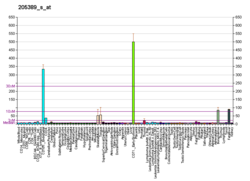Ankyrin-1
| ANK1 | |||||||||||||||||||||||||||||||
|---|---|---|---|---|---|---|---|---|---|---|---|---|---|---|---|---|---|---|---|---|---|---|---|---|---|---|---|---|---|---|---|
 | |||||||||||||||||||||||||||||||
| |||||||||||||||||||||||||||||||
| Identifiers | |||||||||||||||||||||||||||||||
| Aliases | ANK1, ANK, SPH1, SPH2, ankyrin 1 | ||||||||||||||||||||||||||||||
| External IDs | OMIM: 612641; MGI: 88024; HomoloGene: 55427; GeneCards: ANK1; OMA:ANK1 - orthologs | ||||||||||||||||||||||||||||||
| |||||||||||||||||||||||||||||||
| |||||||||||||||||||||||||||||||
| |||||||||||||||||||||||||||||||
| |||||||||||||||||||||||||||||||
| Wikidata | |||||||||||||||||||||||||||||||
| |||||||||||||||||||||||||||||||
Ankyrin 1, erythrocytic, also known as ANK1, is a protein that in humans is encoded by the ANK1 gene.[5][6]
Tissue distribution
The protein encoded by this gene, Ankyrin 1, is the prototype of the ankyrin family, was first discovered in erythrocytes, but since has also been found in brain and muscles.[6]
Genetics
Complex patterns of alternative splicing in the regulatory domain, giving rise to different isoforms of ankyrin 1 have been described, however, the precise functions of the various isoforms are not known. Alternative polyadenylation accounting for the different sized erythrocytic ankyrin 1 mRNAs, has also been reported. Truncated muscle-specific isoforms of ankyrin 1 resulting from usage of an alternate promoter have also been identified.[6]
Disease linkage
Mutations in erythrocytic ankyrin 1 have been associated in approximately half of all patients with hereditary spherocytosis.[6]
ANK1 shows altered methylation and expression in Alzheimer's disease.[7][8] A gene expression study of postmortem brains has suggested ANK1 interacts with interferon-γ signalling.[9]
Function
The ANK1 protein belongs to the ankyrin family that are believed to link the integral membrane proteins to the underlying spectrin-actin cytoskeleton and play key roles in activities such as cell motility, activation, proliferation, contact, and maintenance of specialized membrane domains. Multiple isoforms of ankyrin with different affinities for various target proteins are expressed in a tissue-specific, developmentally regulated manner. Most ankyrins are typically composed of three structural domains: an amino-terminal domain containing multiple ankyrin repeats; a central region with a highly conserved spectrin-binding domain; and a carboxy-terminal regulatory domain, which is the least conserved and subject to variation.[6]
The small ANK1 (sAnk1) protein splice variants makes contacts with obscurin, a giant protein surrounding the contractile apparatus in striated muscle.[10]
Interactions
ANK1 has been shown to interact with T-cell lymphoma invasion and metastasis-inducing protein 1,[11] Titin,[12] RHAG[13] and OBSCN.[14]
See also
References
- ^ a b c GRCh38: Ensembl release 89: ENSG00000029534 – Ensembl, May 2017
- ^ a b c GRCm38: Ensembl release 89: ENSMUSG00000031543 – Ensembl, May 2017
- ^ "Human PubMed Reference:". National Center for Biotechnology Information, U.S. National Library of Medicine.
- ^ "Mouse PubMed Reference:". National Center for Biotechnology Information, U.S. National Library of Medicine.
- ^ Lambert S, Yu H, Prchal JT, et al. (March 1990). "cDNA sequence for human erythrocyte ankyrin". Proc. Natl. Acad. Sci. U.S.A. 87 (5): 1730–4. doi:10.1073/pnas.87.5.1730. PMC 53556. PMID 1689849.
- ^ a b c d e "Entrez Gene: ANK1 ankyrin 1, erythrocytic".
- ^ De Jager, P. L.; Srivastava, G; Lunnon, K; Burgess, J; Schalkwyk, L. C.; Yu, L; Eaton, M. L.; Keenan, B. T.; Ernst, J; McCabe, C; Tang, A; Raj, T; Replogle, J; Brodeur, W; Gabriel, S; Chai, H. S.; Younkin, C; Younkin, S. G.; Zou, F; Szyf, M; Epstein, C. B.; Schneider, J. A.; Bernstein, B. E.; Meissner, A; Ertekin-Taner, N; Chibnik, L. B.; Kellis, M; Mill, J; Bennett, D. A. (2014). "Alzheimer's disease: Early alterations in brain DNA methylation at ANK1, BIN1, RHBDF2 and other loci". Nature Neuroscience. 17 (9): 1156–63. doi:10.1038/nn.3786. PMID 25129075.
- ^ Lunnon, K; Smith, R; Hannon, E; De Jager, P. L.; Srivastava, G; Volta, M; Troakes, C; Al-Sarraj, S; Burrage, J; MacDonald, R; Condliffe, D; Harries, L. W.; Katsel, P; Haroutunian, V; Kaminsky, Z; Joachim, C; Powell, J; Lovestone, S; Bennett, D. A.; Schalkwyk, L. C.; Mill, J (2014). "Methylomic profiling implicates cortical deregulation of ANK1 in Alzheimer's disease". Nature Neuroscience. 17 (9): 1164–70. doi:10.1038/nn.3782. PMID 25129077.
- ^ Liscovitch, N; French, L (2014). "Differential Co-Expression between α-Synuclein and IFN-γ Signaling Genes across Development and in Parkinson's Disease". PLoS ONE. 9 (12): e115029. doi:10.1371/journal.pone.0115029. PMC 4262449. PMID 25493648.
{{cite journal}}: CS1 maint: unflagged free DOI (link) - ^ Borzok MA, Catino DH, Nicholson JD, Kontrogianni-Konstantopoulos A, Bloch RJ (November 2007). "Mapping the binding site on small ankyrin 1 for obscurin". J. Biol. Chem. 282 (44): 32384–96. doi:10.1074/jbc.M704089200. PMID 17720975.
{{cite journal}}: CS1 maint: unflagged free DOI (link) - ^ Bourguignon, L Y; Zhu H; Shao L; Chen Y W (July 2000). "Ankyrin-Tiam1 interaction promotes Rac1 signaling and metastatic breast tumor cell invasion and migration". J. Cell Biol. 150 (1). UNITED STATES: 177–91. doi:10.1083/jcb.150.1.177. ISSN 0021-9525. PMC 2185563. PMID 10893266.
{{cite journal}}: Cite has empty unknown parameters:|laysummary=,|laydate=, and|laysource=(help) - ^ Kontrogianni-Konstantopoulos, Aikaterini; Bloch Robert J (February 2003). "The hydrophilic domain of small ankyrin-1 interacts with the two N-terminal immunoglobulin domains of titin". J. Biol. Chem. 278 (6). United States: 3985–91. doi:10.1074/jbc.M209012200. ISSN 0021-9258. PMID 12444090.
{{cite journal}}: Cite has empty unknown parameters:|laydate=,|laysummary=, and|laysource=(help)CS1 maint: unflagged free DOI (link) - ^ Nicolas, Virginie; Le Van Kim, Caroline; Gane, Pierre; Birkenmeier, Connie; Cartron, Jean-Pierre; Colin, Yves; Mouro-Chanteloup, Isabelle (July 2003). "Rh-RhAG/ankyrin-R, a new interaction site between the membrane bilayer and the red cell skeleton, is impaired by Rh(null)-associated mutation". J. Biol. Chem. 278 (28). United States: 25526–33. doi:10.1074/jbc.M302816200. ISSN 0021-9258. PMID 12719424.
{{cite journal}}: Cite has empty unknown parameters:|laydate=,|laysource=, and|laysummary=(help)CS1 maint: unflagged free DOI (link) - ^ Kontrogianni-Konstantopoulos, Aikaterini; Jones Ellene M; Van Rossum Damian B; Bloch Robert J (March 2003). "Obscurin is a ligand for small ankyrin 1 in skeletal muscle". Mol. Biol. Cell. 14 (3). United States: 1138–48. doi:10.1091/mbc.E02-07-0411. ISSN 1059-1524. PMC 151585. PMID 12631729.
{{cite journal}}: Cite has empty unknown parameters:|laysummary=,|laydate=, and|laysource=(help)
Further reading
External links
- ANK1+protein,+human at the U.S. National Library of Medicine Medical Subject Headings (MeSH)
This article incorporates text from the United States National Library of Medicine, which is in the public domain.








